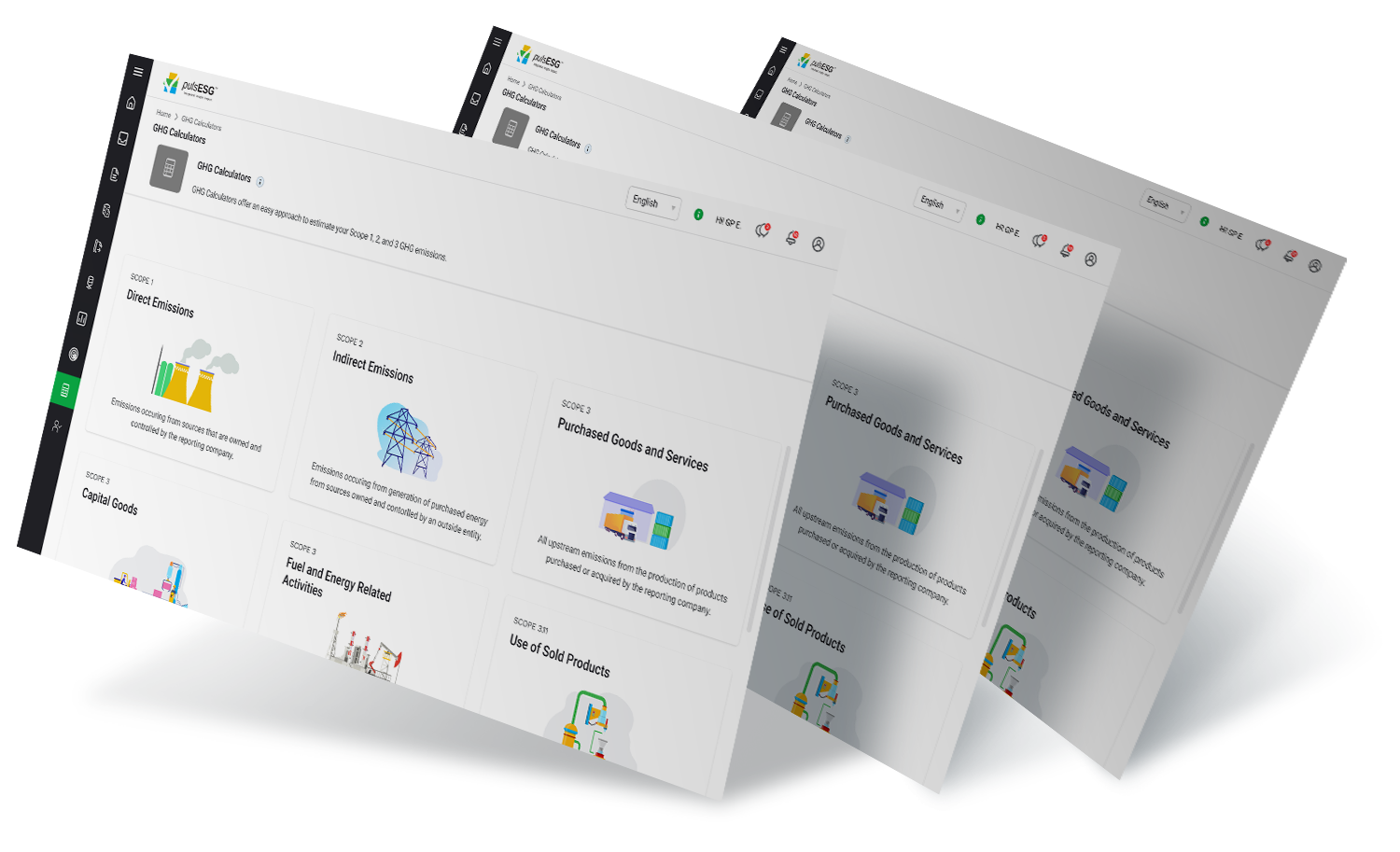pulsESG’s Carbon Calculators
Comprehensive, Accurate and Easy to use GHG emissions calculators

Simple & Easy-to-Use GHG Calculators
- Capture data for location, facility, or building – any level
- Emission factors from IEA, UK DEFRA, or US EPA, or custom
- Market and location-based emissions
- Renewable energy credits and carbon offsets
- Direct data extraction from back-end systems
- ERP, utility meter transaction data, etc. into the calculators
- Granular calculations for all relevant GHG emission categories
- Aggregation across any org level
Direct Emissions
Scope 1

Measure and report emissions from direct emission sources, such as:
- combusting different types of solid, liquid, gaseous, and biofuels at company sites
- fuel usage in shipping vehicles within the company premises
- refrigerant leakage from the usage of cold storage
Indirect Emissions
Scope 2

Measure and report emissions using both location based approach that uses grid average emission factors and market based approach that uses supplier specific or residual mix emission factors.
Purchased Goods and Services
Scope 3.1

Measure and report emissions for a wide range of products (Metals, Electronic items, Paper and Plastics) using the weight details of the purchased good or total amount spent on acquiring the purchased good.
Fuel and Energy Related Activities
Scope 3.3

Measure and report emissions using well to tank emission factors for the fuels that are burnt at the facilities.
Upstream Transportation and Distribution
Scope 3.4

Measure and report emissions from fuel consumed by the vehicles that are used for transporting the raw material from supplier location to the production facilities. Can capture various freight modes such as via air, sea, and road.
Waste Generated in Operations
Scope 3.5

Measure and report emissions from different types of solid, liquid and water waste generated during manufacturing of products at company sites.
Business Travel
Scope 3.6

Measure and report emissions from different modes of transport used by employees for domestic and international business travel. Connect to your expense management system and calculate emissions using the amount spent on each business trip.
Hotel Stay
Scope 3.6

Measure and report emissions due to employees staying at hotels during the business trips to different countries across the world.
Employee Commuting
Scope 3.7

Measure and report emissions from different modes of public and private transport taken by employees for commuting between office and their homes.
Home Office / Telecommuting
Scope 3.7

Measure and report emissions from increased power consumption due to employees working from home and using different types of heating, cooling and home office equipment.
Upstream Leased Assets
Scope 3.8

Measure and report emissions from the consumption of fuel, electricity and refrigerant leakage by the assets reporting company has leased from a different entity.
Downstream Transportation and Distribution
Scope 3.9

Measure and report emissions from different types of freight used for shipping finished goods from company site to the customer locations.
Processing of Sold Products
Scope 3.10

Measure and report emissions from different types of processes that a product will undergo at different customer sites as your product will be an intermediate product to your customers.
Use of Sold Products
Scope 3.11

Measure and report emissions from consumer use over the lifetime of a product.
End-of-Life Treatment of Sold Products
Scope 3.12

Measure and report emissions from the product waste as it becomes unusable at the end of its life and has to be disposed of.
Downstream Leased Assets
Scope 3.13

Measure and report emissions from the consumption of fuel, electricity and refrigerant leakage by the assets reporting company has leased to a different entity.
Franchises
Scope 3.14

Measure and report scope 1 and scope 2 emissions of the franchises
Investments
Scope 3.15

Measure and report emissions proportionate to the amount of investments made in companies and projects. Collect Scope 1 and Scope 2 emissions directly from investees or use high level sectoral data to estimate the emissions.
